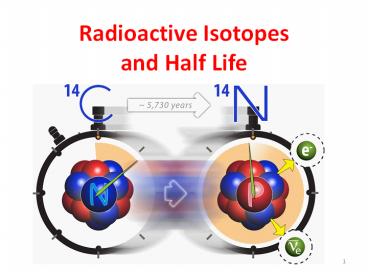Radioactive Isotopes and Half Life - PowerPoint PPT Presentation
1 / 12
Title:
Radioactive Isotopes and Half Life
Description:
Each time you click, one half-life goes by and turns red. C14 ... JASON_SOX Created Date: 4/28/2005 7:54:31 PM Document presentation format: Custom Company: – PowerPoint PPT presentation
Number of Views:120
Avg rating:3.0/5.0
Title: Radioactive Isotopes and Half Life
1
Radioactive Isotopes and Half Life
2
What is a Radioactive Isotope? What is
Radioactive Decay? What is Half Life?
3
Radioactive Isotopes
Radioactive elements are unstable. They decay,
and change into different elements over time.
Not all elements are radioactive. Those that
are listed below are the most useful for geologic
dating of fossils are U-238 Half-life 4.5
Billion Years K-40 Half-life 1.25 Billion
Years C-14 Half-life 5, 730 Years
4
Radioactive Decay and Half Life
Here are some facts to remember
- The half-life of an element is the time it takes
for half of the material you started with to
decay. - 2. Each element has its own half-life.
5
Radioactive Decay and Half Life
- Each element decays into a new element
- - C14 decays into N14
- 4. The half-life of each element is constant.
Its like a clock keeping perfect time. - Now lets see how we can use half-life to
determine the age of a rock, fossil or other
artifact.
6
The blue grid below represents a quantity of C14.
Each time you click, one half-life goes by and
turns red. C14 blue N14 - red
Half lives C14 N14 Time elapsed
0 100 0 0 years
As we begin notice that no time has gone by and
that 100 of the material is C14
7
The grid below represents a quantity of C14. Each
time you click, one half-life goes by and you see
red. C14 blue N14 - red
Half lives C14 N14 Time Elapsed
0 100 0 0 years
1 50 50 5,730 years
After 1 half-life (5730 years), 50 of the C14
has decayed into N14. The ratio of C14 to N14 is
11. There are equal amounts of the 2 elements.
8
The blue grid below represents a quantity of C14.
Each time you click, one half-life goes by and
you see red . C14 blue N14 - red
Half lives C14 N14 Time Elapsed
0 100 0 0 years
1 50 50 5,730 years
2 25 75 11,460 years
Now 2 half-lives have gone by for a total of
11,460 years. Half of the C14 that was present at
the end of half-life 1 has now decayed to N14.
Notice the CN ratio. It will be useful later.
9
The blue grid below represents a quantity of C14.
Each time you click, one half-life goes by and
you see red. C14 blue N14 - red
Half lives C14 N14 Time Elapsed
0 100 0 0 years
1 50 50 5,730 years
2 25 75 11,460 years
3 12.5 87.5 17,190 years
After 3 half-lives (17,190 years) only 12.5 of
the original C14 remains. For each half-life
period half of the material present decays. And
again, notice the ratio, 17
10
(No Transcript)
11
Band of Stability
Stable, naturally occurring isotopes
- For low atomic numbers the stable nuclei are
those with a ratio of protons to neutrons approx.
11 - As the atomic increases, the stable ratio
increases to about 1.5 1.
1
12
Band of Stability
Stable, naturally occurring isotopes
- If an isotope falls above the band, then it
needs to lose neutrons and gain more protons to
become stable. How would it achieve that? - If an isotope had too many protons and too many
neutrons, how would it become stable?
Alpha Decay
Beta Decay
Positron Emission
1

